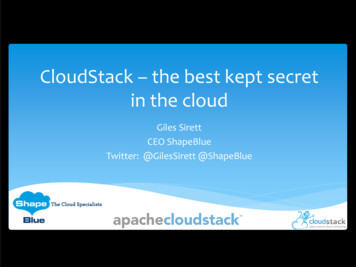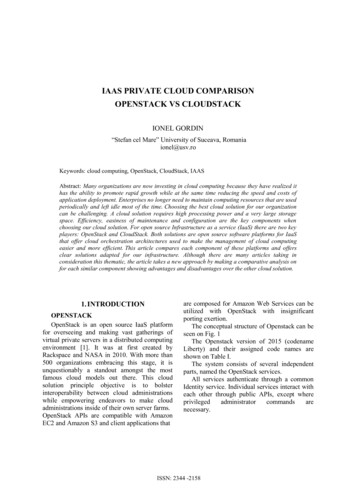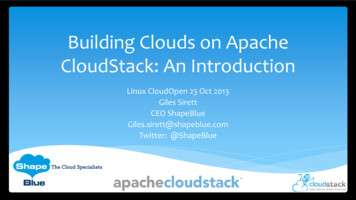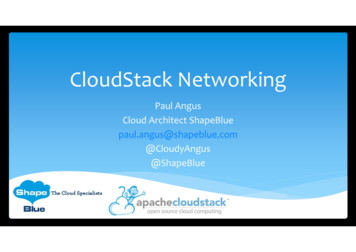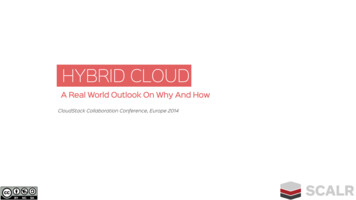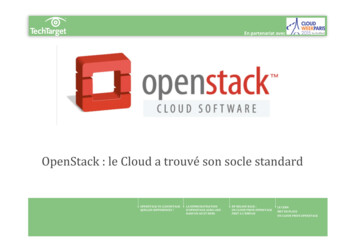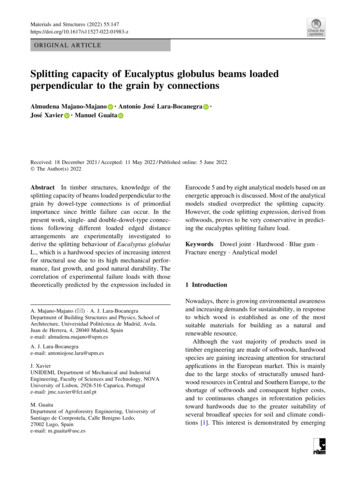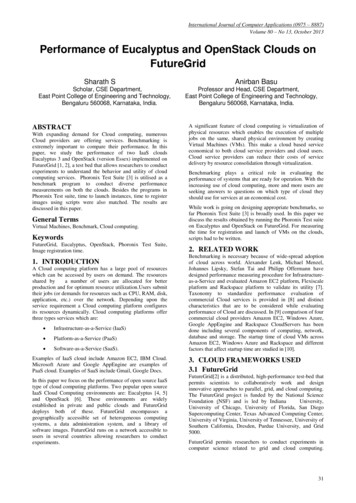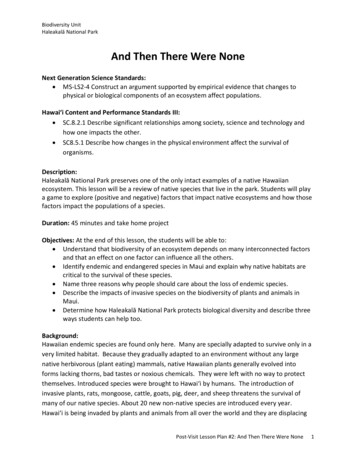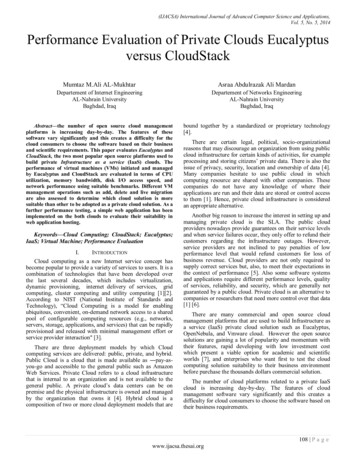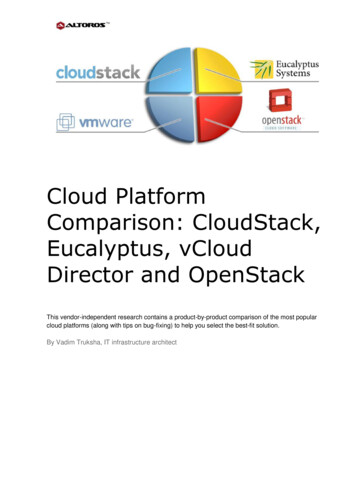
Transcription
Cloud PlatformComparison: CloudStack,Eucalyptus, vCloudDirector and OpenStackThis vendor-independent research contains a product-by-product comparison of the most popularcloud platforms (along with tips on bug-fixing) to help you select the best-fit solution.By Vadim Truksha, IT infrastructure architect
Cloud Platform Comparison: CloudStack, Eucalyptus,vCloud Director, and OpenStackTable of contents1. Introduction . 32. CloudStack 3.0.0 . 32.1 Main Features . 32.2 Price . 42.3 Community . 42.4 Documentation . 42.5 Experience . 42.6 Possible issues and bug fixes . 42.7 Conclusion . 53. Eucalyptus Open Source 2.0.3 . 53.1 Main features . 53.2 Price . 53.3 Community . 53.4 Documentation . 53.5 Experience . 53.6 Possible issues and bug fixes . 63.7 Conclusion . 64. vCloud Director 1.5 . 74.1 Main features . 74.2 Price . 74.3 Community . 74.4 Documentation . 74.5 Experience . 74.6 Conclusion . 75. OpenStack 2011.3 . 85.1 Main features . 85.2 Price . 85.3 Community . 85.4 Documentation . 85.5 Experience . 85.6 Conclusion . 86. Summary . 9Table: Detailed Cloud Computing Platforms Comparison . 97. About Altoros .10 Altoros2
Cloud Platform Comparison: CloudStack, Eucalyptus,vCloud Director, and OpenStack1. IntroductionCloud computing remains one of the hottest topics in IT today given the promise of greatlyimproved efficiencies, significant cost savings, scalable infrastructure, high performance andsecured data storage.Choosing the appropriate cloud platform, however, can be difficult. They all have pros and cons.So, when a customer asked me and my colleagues at Altoros Systems, a software productdevelopment company, what would be the best cloud platform for his project and why, wedecided to take a deep look at the most notable systems available, compare their capabilities,and summarize the findings in a product-by-product table. We tested CloudStack, Eucalyptus,vCloud Director and OpenStack.Below you will find information on features available in free and commercial versions of the cloudplatforms, their price, documentation completeness, and community matureness. In addition, theerrors found during the deployment process are addressed by detailed instructions on bug fixing.(Please note that by the time the research is published the products may be updated by thevendors.)The goal of this unbiased comparison is to help you align your business requirements with thecapabilities of a particular cloud system and – finally – select the best-fit product.2. CloudStack 3.0.0CloudStack is a console for managing data center computing resources. A number of well-knowninformation-driven companies, such as Zynga, Nokia Research Center and Cloud Central, havedeployed clouds using CloudStack. Apart from having its own API, the platform supportsCloudBridge Amazon EC2, which enables converting an Amazon API into a CloudStack API. Youcan find a detailed list of the supported commands here.2.1 Main Features: Hypervisors agnostic (KVM, XEN, ESXi, OVM and BareMetal) Roles (assigning and managing permissions) Virtual network (VLAN support) Resource pool (enables administrators to limit virtual resources, for example, the number ofvirtual machines that can be created by one account, the number of public IP addressesassigned to an account, etc.) Snapshots and volumes Virtual routers, a firewall, and a load balancer Live migration with host maintenance Altoros3
Cloud Platform Comparison: CloudStack, Eucalyptus,vCloud Director, and OpenStackIf your data center is based on vSphere, CloudStack will use a vCenter API. This means that youwill be able to manage your data processing center that has been dynamically deployed usingvSphere 4.1.2.2 Price: CloudStack is distributed for free under the GNU Public License v3. To get paidsupport, you should contact its developers via email.2.3 Community: There is an online community ready to provide timely technical support forfree. You can find solutions to many CloudStack issues on the Forum. There is also an IRCchannel where everyone is welcome to ask questions.2.4 Documentation: If you have a basic technical background, it will be rather easy for you toinstall the CloudStack platform with default settings. If a more complex and complicatedinstallation is required, you might experience some challenges, as the documentation does notcover complex issues in full. The manual gives step-by-step instructions but does not provide anyinformation on how the platform functions in general.2.5 Experience: We have performed installation, configured the system, and tried VMware aswell as KVM clusters. CentOS 5.5 and CentOS 6.2 were used for the hosts. In addition, ourengineering team connected our private cloud deployed with CloudStack to the RightScalemanagement console. The platform was easy to install and performed as expected.2.6 Possible issues and bug fixes: Some errors in running libvirtd may arise when usingCentOS 6. The problem can be solved by adding the following code to /etc/cgconfig.conf:group virt {cpu {cpu.shares 9216;}}After entering the code, restart /etc/init.d/cgconfig and launch libvirtd.Using the console on a website may also cause some problems. One of them is that the vncserver uses 127.0.0.1 as the default address for the hosts. To check this, execute the followingcommand:netstat -nlp grep kvmtcp00 0.0.0.0:5900tcp00 0.0.0.0:5901tcp00 0.0.0.0:5902tcp00 15227/qemu-kvm12587/qemu-kvm Altoros4
Cloud Platform Comparison: CloudStack, Eucalyptus,vCloud Director, and OpenStackIn case the address is 127.0.0.1, you should uncomment the vnc listen "0.0.0.0" line in theconfiguration file:/etc/libvirt/qemu.conf and restart the virtual machines.2.7 Conclusion: Working with CloudStack management console has made a rather positiveimpression on our engineering team. This is a rapidly developing tool that provides broadfunctionality and is available for free. It may be employed for production but, if you use VMwarehypervisors, vCloud Director seems like a better choice.3. Eucalyptus Open Source 2.0.3Eucalyptus is another popular cloud platform. Sony, Puma, NASA, Trend Micro and othercompanies have chosen it to deploy their private clouds. Eucalyptus has a free version and acommercial edition. Obviously, the commercial edition comes with much more extendedfunctionality.One of the greatest advantages making this platform truly convenient to work with is that theEucalyptus API is fully compatible with the Amazon API. As a result, all the scripts and softwareproducts based on the Amazon API can be easily employed for your private cloud. Eucalyptussupports three hypervisors: XEN, KVM and ESXi. The last one is only available to the users ofthe Enterprise Cloud edition.3.1 Main features: Roles (assigning and managing permissions) Hypervisor agnostic Clustering and zoning Flexible network management, security groups, and traffic isolation3.2 Price: You can choose between the open-source free Eucalyptus Cloud and the EucalyptusEnterprise Cloud. Information on differences in functionality is available here.3.3 Community: Like any other open-source product, Eucalyptus has a powerful communitythat contributes to platform development and assists in finding and fixing bugs. We did notexperience any difficulties when installing and configuring this product, so we cannot comment onhow helpful the community is. Anyway, they did a great job developing the product.3.4 Documentation: Product documentation covers the installation process but does notprovide much information on any other aspects of working with the software. A prospective usershould have a strong technical background, because the guides provide no information onvirtualization and become useless, if a more complicated configuration is required.3.5 Experience: Our team installed the open-source version and configured the platformfollowing the instructions provided in the documentation. We used CentOS 5.5 for the cloud Altoros5
Cloud Platform Comparison: CloudStack, Eucalyptus,vCloud Director, and OpenStackcontroller and CentOS 5.5 together with XEN hypervisor for the hosts. Our cloud wassuccessfully added to RightScale. There is no management console, so you have to either useeuca2tools or combine Eucalyptus with RightScale. The commercial version of the product doeshave a management console, which makes it more user-friendly.3.6 Possible issues and bug fixes:1) Some of the dependencies failed to install in turns. As a solution to this, we installed them in apackage at a time.rpm -Uvh python25-2.5.1-bashton1.x86 64.rpmerror: Failed dependencies:libpython2.5.so.1.0()(64bit) is needed by python25-2.5.1-bashton1.x86 64The solution:rpm -Uvh python25-2.5.1-bashton1.x86 64.rpm python25-devel-2.5.1-bashton1.x86 64.rpm python25-libs2.5.1-bashton1.x86 64.rpm2) After the installation is completed, the following errors may occur, when the controller islaunched:/etc/init.d/eucalyptus-cc startStarting Eucalyptus cluster controller:Enabling IP forwarding(13)Permission denied: make sock: could not bind to address [::]:8774(13)Permission denied: make sock: could not bind to address 0.0.0.0:8774no listening sockets available, shutting downUnable to open logsFailed to start the CC!To solve this issue, Selinux should be disabled.3) If you do not have sufficient experience with XEN, you may encounter some problems whenusing it. After the installation of XEN is completed, the value of the parameter default 1 should bechanged to default 0 in this configuration file: /etc/grub/menu.lst to load XEN core.4) It is also advisable to create a group called libvirt in CentOS and add the account used forrunning Eucalyptus to this group.3.7 Conclusion: Though the open-source version of the product has a number of issues, thereare simple workarounds. Furthermore, the commercial edition provides a broader functionality(VMware hypervisor tools, compatibility with Amazon AWS, AD and LDAP integration, etc.).Those who already have a virtual environment can enhance it with a Eucalyptus cloud instead ofcomplete migration. Altoros6
Cloud Platform Comparison: CloudStack, Eucalyptus,vCloud Director, and OpenStack4. vCloud Director 1.5vCloud Director is a platform for deploying clouds developed by VMware. The system enablesbuilding hybrid clouds and, if the entire infrastructure in your office is built using VMwareproducts, you will have no difficulties with implementing vCloud Director. You can migrate yourvirtual machines between private and public clouds using VMware vCloud Connector.4.1 Main features: Virtual data centers vShield security technologies Infrastructure service catalog Multi-tenant organizations Self-service portal VMware vCloud API, open virtualization format, and callouts4.2 Price: Unfortunately, there are no free editions of the product. You have to contact aregional manager to find out the approximate cost of a package that would meet yourrequirements.4.3 Community: VMware is one of the leaders in the market and has a very large community.There is also a rich knowledge base, which can be used as a free support service. The productcomes with a support package and the company offers additional paid support on demand.4.4 Documentation: Proprietary software usually comes with high quality documentation, andthis platform is no exception. There will be no difficulties, if you carefully follow all the instructionsprovided in the guides.4.5 Experience: We successfully installed and configured vCloud Director. It should bementioned, that Red Hat is required in order to install this platform. Other things you will need forinstallation include vCenter (with clusters and DRS), and vShield.Obviously vCloud Director uses the vCenter API. This means a user of vCloud Director hasaccess to the full functionality implemented in vSphere.4.6 Conclusion: This is a commercial product and that is a big disadvantage for some users.However, if you already use VMware for virtualization, vCloud Director will be the mostappropriate choice. Altoros7
Cloud Platform Comparison: CloudStack, Eucalyptus,vCloud Director, and OpenStack5. OpenStack 2011.3OpenStack 2011.3 is an open-source platform for deploying clouds. This project includes threeproducts: Nova (an analog to Amazon EC2), Swift (an analog to Amazon S3), and Glance (anAPI server that provides discovery, registration, and delivery services for virtual disk images). Inour research, we only used Nova, but you should pay close attention to Swift, which offersscalable object storage for petabytes of accessible data. OpenStack 2011.3 is supported bymany vendors, including CloudStack 3.Currently, Nova fully supports two hypervisors: KVM and XEN. The platform is being developedrapidly and soon will be provided with a broader functionality. The technology is popular among alarge community of specialists and is backed by such companies as Cisco, Dell, NASA, Intel,AMD, Citrix, Rackspace, and RightScale. The core of this product is developed by NASA.5.1 Main features: Ability to manage virtualized commodity server resources Ability to manage local area networks Virtual machine image management Security groups Role-based access control Projects & quotas VNC proxy through a Web browser5.2 Price: OpenStack 2011.3 is open-source and can be downloaded for free. The project isdeveloped by various contributors and exists mainly on user donations.5.3 Community: In comparison to other products mentioned in this research, OpenStackseems to have the largest and the most active community. The community members are alwayswilling to help others find solutions to any arising problems.5.4 Documentation: However, OpenStack documentation is somewhat incomplete. Due tothe rapid development of the product, the documentation fails to cover all the current issues andnew features in time. Often you have to visit forums or use IRC to get the required information.5.5 Experience: We have successfully installed and configured Nova, Keystone, anddashboard without any critical issues.5.6 Conclusion: This open-source platform is free and is being developed very rapidly. Itdemonstrates a lot of progress, but still lots of development efforts are required before it can beused for production. OpenStack 2011.3 is already compatible with Amazon API and thedashboard project is currently under consideration. Altoros8
Cloud Platform Comparison: CloudStack, Eucalyptus,vCloud Director, and OpenStack6. SummaryIf you decide to move your business to the cloud, one of the first tasks you will encounter ischoosing a platform that will better fit your company's requirements. Though it may be hard tounderstand what stands behind the vendor's promises in marketing descriptions, I hope thisarticle will help a bit. This research is the result of working with all of the cloud products and is notaimed at promoting any of the systems.There is no silver bullet, and even the best cloud platform (if any exists) can hardly satisfy all ofthe demands and use cases. For a particular type of business, you need to investigate all thefactors involved, define your typical tasks, calculate the risks, allocate a budget, and compare itagainst the platforms' capabilities and license costs. It will be a compromise, any way you look atit. The thing is to make sure you have made the best possible choice in the very beginning.Table: Detailed Cloud Computing Platforms Comparison (plus being a positive, minus beinga negative, with footnotes adding detail)CloudStack3.0.0FeaturesAD Integration \-Eucalyptus2.0.3vCloudDirector 1.5OpenStack2011.3(1)- - \-Management Console -(2)Web Access to the vm Console -(4) API Multi-role Support VLANS Hypervisor Agnostic(5)(6)(7) (3)(8) Easy Template Creation Process - -Snapshots Alerts and Notifications - -Volumes - - -Free (-10)- Amazon API Compatibility - RightScale - \- - - -ResourceLimitsOverProvisioningGuest OS Preferencesand(9)Host Maintenance with Live MigrationHigh Availability Cloud Component(12)Implementation Complexity \-(11) Altoros9
Cloud Platform Comparison: CloudStack, Eucalyptus,vCloud Director, and OpenStackNotes:1. CloudStack does not provide users with a GUI for setting up AD integration, but the APIenables doing this. We wrote a script nd-active-directory.html) to make ADintegration easier.2. The management console of Eucalyptus is implemented in the commercial version.3. The management console of OpenStack has already been developed, but has not beenincluded into the product’s API yet. Supposedly, it will be added in the next release.4. Web access to the vm console of Eucalyptus is only available when working with KVM.5. CloudStack 3.0.0 supports KVM, XEN, ESXi, OVM, and BareMetal.6. Eucalyptus 2.0.3 supports KVM, XEN, ESXi but hypervisor agnostic of Eucalyptus is onlyavailable in the commercial edition.7. vCloud Director 1.5 only supports ESXi.8. OpenStack 2011.3 supports XEN and KVM.9. The type of guest OS for all the platforms is determined by hypervisors, particularly,Eucalyptus only supports Linux guests.10. Eucalyptus has both commercial and free versions.11. We had a possibility to test the platforms with a developer account of Rightscale. It isimpossible to enable OpenStack from a client’s account, but this can be done from a developer’saccount. The functionality works well, so it is unclear why this product is still not supported.12. Complicated installation and configuration combined with a not-at-all-user-friendly interfacecan make implementation very challenging. In any case, it is rather complicated to conclude howdifficult it is to install and configure a platform in the test mode. Cloudstack and vCloud are easierto install.7.About AltorosAltoros provides consulting and managed services around Cloud Foundry PaaS, multi-clouddeployment automation, and complex Java/.NET/Ruby architectures that make heavy use ofSQL/NoSQL/Hadoop clusters. Altoros employs 250 senior- and mid-level engineers across 8countries, including one of the largest pools of Cloud Foundry expertise on the market. For more,please visit www.altoros.com or follow @altoros. Altoros10
Comparison: CloudStack, Eucalyptus, vCloud Director and OpenStack This vendor-independent research contains a product-by-product comparison of the most popular cloud platforms (along with tips on bug-fixing) to help you select the best-fit solution. By Vadim Truksha, IT infrastructure architect
